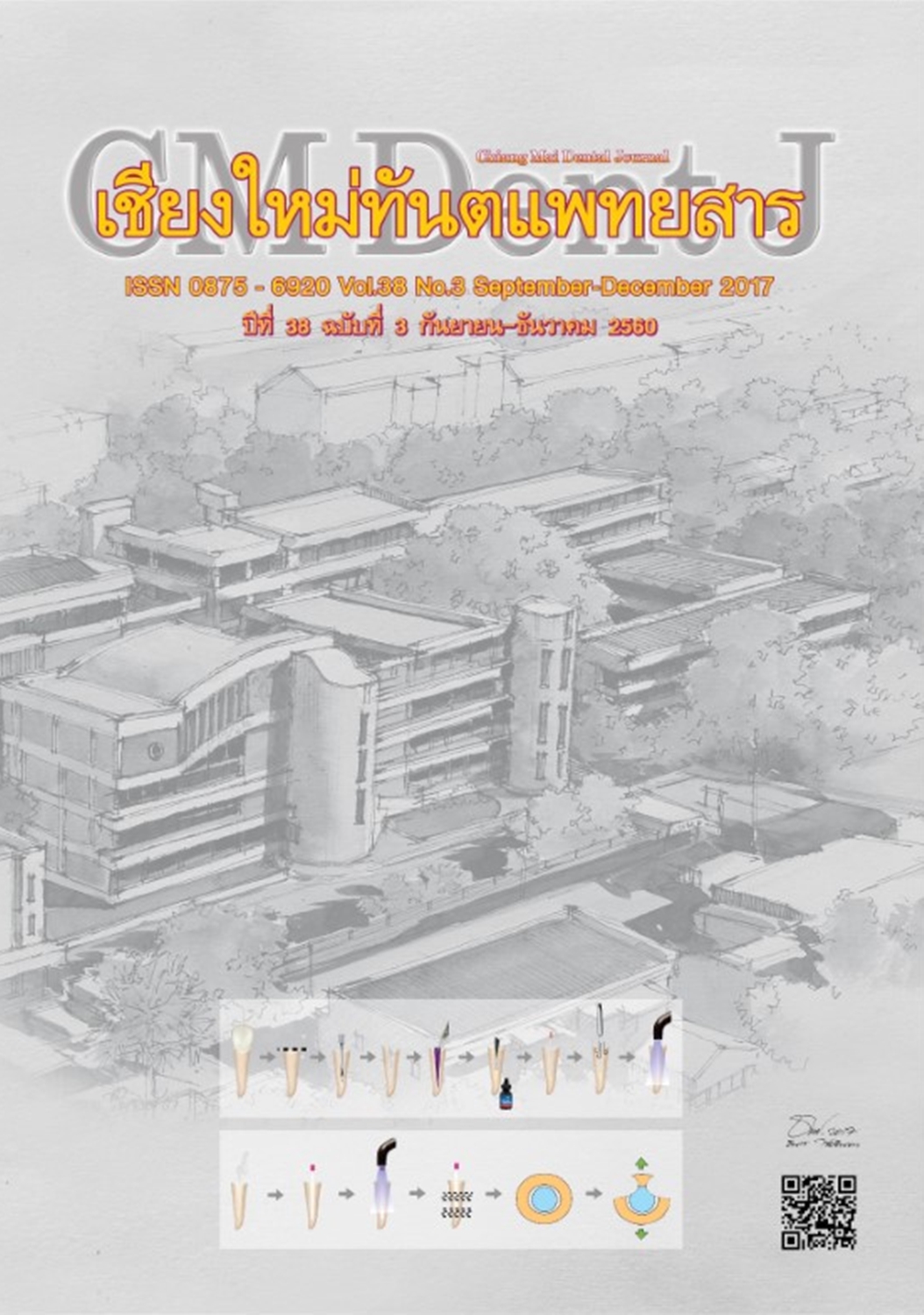The Flow of Distilled Water on Ceramic Plate Treated with Various Types of Silane Coupling Agent Solution
Main Article Content
Abstract
Objective: The aim of this study was to investigate the flow of distilled water on ceramic plate treated with various types of silane coupling agent solution.
Materials and Methods: Forty pieces of 10x10x1 mm ceramic plates were polished with 1000 grit sandpaper to smoothing and were standardized using profilometer. The specimens were divided into 4 groups; which were: 1 controlled group and 2, 3, 4 treated ceramic plate with MPS APS and AAPS. Water flow on ceramic plates was tested. The contact angle between distilled water and ceramic surface was measured using a contact angle tester. Average contact angle values were analyzed using 1-way analysis of variance followed by Tukey’s multiple comparison test (α = 0.05).
Results: MPS silane coupling agent-treated ceramic plate group demonstrated the significantly lowest contact angle values, whereas control group showed the highest values among the tested groups.
Conclusions: Surface roughness of all ceramic plates was similar. The lowest contact angle value was exhibited in ceramic plates treated with MPS silane coupling agent group.
Article Details
References
Passos SP, Valandro LF, Bottino MA, Santos MJ, Santos GC, Jr. Shear bond strength of resin cement bonded to alumina ceramic after treatment by aluminum oxide sandblasting or silica coating. J Prosthodont 2011; 20(7): 561-565.
Murthy V, Manoharan, Balaji, Livingstone D. Effect of four surface treatment methods on the shear bond strength of resin cement to zirconia ceramics- a comparative in vitro study. J Clin Diagn Res 2014; 8(9): ZC65-ZC68.
Osorio E, Aguilera FS, Osorio R, Garcia-Godoy F, Cabrerizo-Vilchez MA, Toledano M. Determining efficacy of monitoring devices on ceramic bond to resin composite. Med Oral Patol Oral Cir Bucal 2012; 17(5): c833-c840.
Sciasci P, Abi-Rached FO, Adabo GL, Baldissara P, Fonseca RG. Effect of surface treatments on the shear bond strength of luting cements to Y-TZP ceramic. J Prosthet Dent 2015; 113(3): 212-219.
Su N, Yue L, Liao Y, Liu W, Zhang H, Li X, et al. The effect of various sandblasting conditions on surface changes of dental zirconia and shear bond strength between zirconia core and indirect composite resin. J Adv Prosthodont 2015; 7(3): 214-223.
Moon JE, Kim SH, Lee JB, Han JS, Yeo IS, Ha SR. Effects of airborne-particle abrasion protocol choice on the surface characteristics of monolithic zirconia materials and the shear bond strength of resin cement. Ceram Int 2016; 42(1) Part B: 1552-1562.
Lohbauer U, Zipperle M, Rischka K, Petschelt A, Muller FA. Hydroxylation of dental zirconia surfaces: characterization and bonding potential. J Biomed Mater Res B Appl Biomater 2008; 87(2): 461-467.
Chaijareenont P, Takahashi H, Nishiyama N, Arksornnukit M. Effect of different amounts of 3-methacryloxypropyltrimethoxysilane on the flexural properties and wear resistance of alumina reinforced PMMA. Dent Mater J 2012; 31(4): 623-628.
Piconi C, Maccauro G. Zirconia as a ceramic biomaterial.Biomaterials 1999; 20(1): 1-25.
Thompson JY, Rapp MM, Parker AJ. Microscopic and energy dispersive x-ray analysis of surface adaptation of dental cements to dental ceramic surfaces. J Prosthet Dent 1998; 79(4): 378-383.
Kelly JR, Giordano R, Pober R, Cima MJ. Fracture surface analysis of dental ceramics: Clinically failed restorations. Int J Prosthodont 1990; 3(5): 430-440.
Kelly JR, Campbell SD, Bowen HK . Fracture-surface analysis of dental ceramics. J Prosthet Dent 1989; 62(5): 536-541.
Anusavice KJ, Hojjatie B. Tensile stress in glass-ceramic crowns:effect of flaws and cement voids. Int J Prosthodont 1992; 5(4): 351-358.
Ozcan M, Alkumru HN, Gemalmaz D. The effect of surface treatment on the shear bond strength of luting cement to a glass-infiltrated alumina ceramic. Int J Prosthodont 2001; 14(4): 335-339.
Lausund KB, Johnsen BB, Rahbek DB, Hansen FK. Surface treatment of alumina ceramic for improved adhesion to a glass fibre-reinforced polyester composite. Intl J Adhesion Adhesives 2015; 63(2): 34-45.
Ozcan M, Vallittu PK. Effect of surface conditioning methods on the bond strength of luting cement to ceramics. Dent Mater 2003; 19(8): 725-731.
de Carvalho RF, Martins ME, de Queiroz JR, Leite FP, Ozcan M. Influence of silane heat treatment on bond strength of resin cement to a feldspathic ceramic. Dent Mater J 2011; 30(3): 392-397.
Wahsh MM, Ghallab OH. Influence of different surface treatments on microshear bond strength of repair resin composite to two CAD/CAM esthetic restorative materials. Tant Dent J 2015; 12(3): 178-184.
Lung CY, Matinlinna JP. Aspects of silane coupling agents and surface conditioning in dentistry: an overview. Dent Mater 2012; 28(5): 467-477.
Chaijareenont P, Takahashi H, Nishiyama N, Arksornnukit M. Effects of silane coupling agents and solutions of different polarity on PMMA bonding to alumina. Dent Mater J 2012; 31(4): 610-616.
Sharfrin EG, Zisman WA, William A. Constitutive relations in the wetting of low energy surfaces and the theory of the retraction method of preparing monolayers. J Phys Chem 1960; 64(5): 519–524.
Eustathopoulos N, Nicholas MG, Drevet B. Wettability at high temperatures1999. Oxford, UK: Pergamon.
Arkles B, Steinmetz JR, Zazyczny J, Mehta P. In: K.L. Mittal (ed.), Silanes and other coupling agents, pp. 91-104. Utrecht: VSP, 1992.

